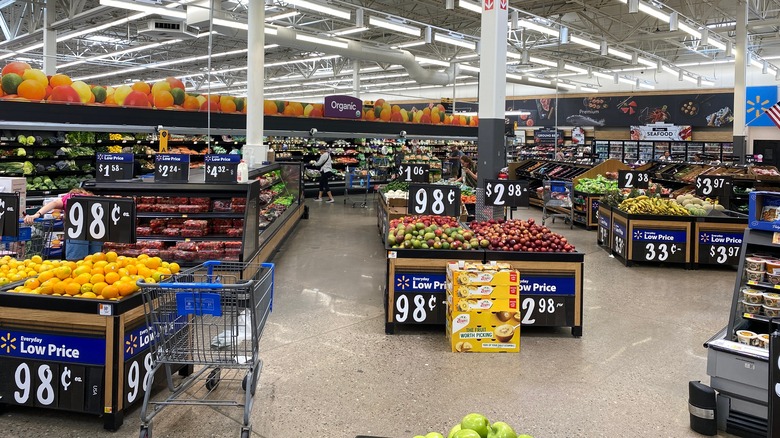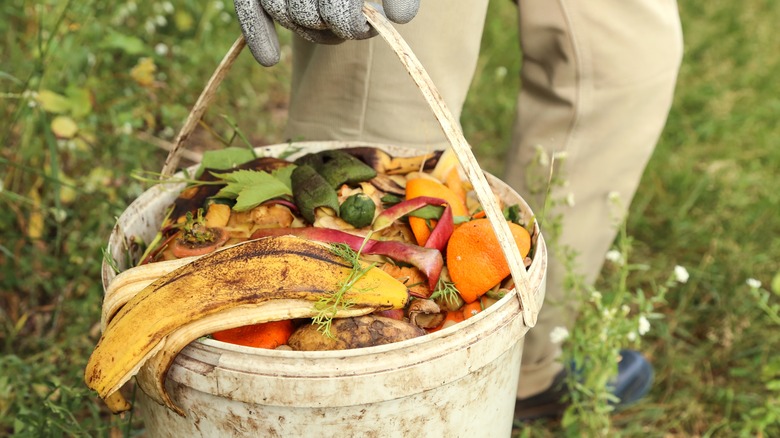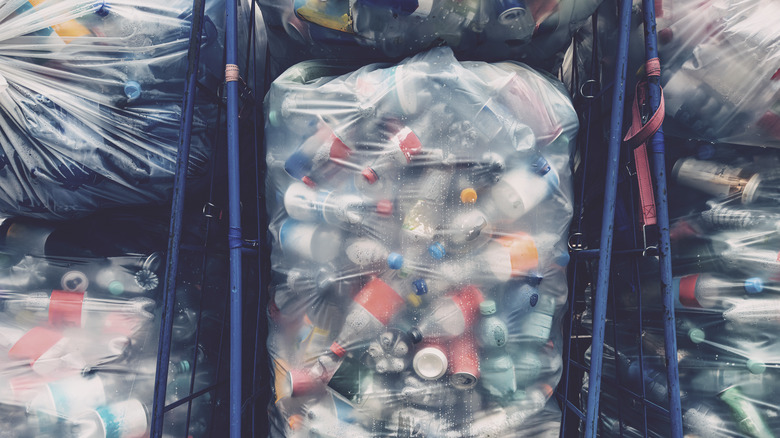How Walmart Has Been Trying To Fix Its Major Waste Problem
Walmart is one of the world's largest retailers and with that scale comes a sizable amount of waste. From discarded groceries to mountains of packaging, the company has long been criticized for how much stuff ends up in the trash. A 2016 CBC Marketplace investigation found that Walmart stores in Canada were throwing out perfectly good food, much of it unopened. This discovery sparked public backlash and renewed calls for accountability. Since then, Walmart has pledged to clean up its act, though it remains to be seen whether the results of its efforts have actually paid off.
In recent years, Walmart has rolled out a range of waste-reduction efforts aimed at both food and packaging. As of 2022, the company reported generating 21 million metric tons of packaging waste and 383,000 metric tons of food waste globally. It's a huge number, but Walmart handles a lot of our products and it says it's working to shrink that footprint through more efficient inventory systems, expanded food donation programs, and sustainable packaging innovation.
The company's stated goal is to become a zero-waste business in key markets like the United States, Mexico, Japan, and Canada. This is just one of the ways that Walmart is preparing for the future. One thing is clear: The company is trying to innovate on how such a massive grocery and general merchandise chain deals with the inevitable waste it produces.
Pushing for less food waste one shelf at a time
One of Walmart's biggest waste-related issues is food. There are already some shady things going on in the grocery department, but it goes beyond that. With thousands of stores handling perishable groceries every day, it's inevitable that some items go bad before they're sold. Still, Walmart has faced scrutiny not just for spoiled goods, but for tossing out food that was still safe to eat. (To be fair, there's still speculation as to whether it was warranted.) In general, there have been questions about how supermarkets, restaurants, and other commercial establishments handle discarding food. In response to the backlash it has received, Walmart has made food waste reduction a major focus of its sustainability platform.
Walmart now works with food banks and donation networks to divert unsold, edible food away from landfills. In 2022, it donated over 696 million pounds of food to hunger relief programs. Walmart also aims to improve how it predicts demand, so stores stock just the right amount without over-ordering. Shelf-life extension efforts and clearer date labeling on products are likewise part of the strategy.
One piece of the puzzle is customer education. Walmart's sustainability page emphasizes helping consumers understand the difference between "best by" and "use by" dates, which could prevent good food from being tossed prematurely.
Tackling packaging and retail waste with circular thinking
Outside of taking steps to reduce food waste, Walmart's sustainability challenge includes the massive amount of packaging and general retail waste it produces. Plastic wrappers, cardboard boxes, and product containers pile up across its supply chain. To address this, Walmart has committed to moving toward a circular economy — a system in which materials are reused or recycled instead of discarded.
According to its environmental impact reports, Walmart is shooting for 100% recyclable, reusable, or industrially compostable packaging for its private-brand products by 2025. It's also working with suppliers to reduce unnecessary materials and redesign packaging to be more efficient. The company has been retrofitting stores with waste-sorting stations and working to compost organic waste where possible.
In the United Kingdom and other select markets, Walmart wants to reach zero waste to landfill status. However, some sustainability watchdogs point out that only a small percentage of its global operations currently meet that benchmark. Walmart's size makes any effort at sustainability an uphill climb, but it also gives the company an opportunity to lead. Whether it can truly shift to a waste-conscious retail model remains a work in progress but it's efforts toward tackling the issue seem promising.


